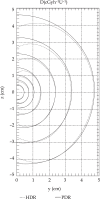Comparison of (60)Co and (192)Ir sources in HDR brachytherapy
- PMID: 23346129
- PMCID: PMC3551360
- DOI: 10.5114/jcb.2011.26471
Comparison of (60)Co and (192)Ir sources in HDR brachytherapy
Abstract
This paper compares the isotopes (60)Co and (192)Ir as radiation sources for high-dose-rate (HDR) afterloading brachytherapy. The smaller size of (192)Ir sources made it the preferred radionuclide for temporary brachytherapy treatments. Recently also (60)Co sources have been made available with identical geometrical dimensions. This paper compares the characteristics of both nuclides in different fields of brachytherapy based on scientific literature. In an additional part of this paper reports from medical physicists of several radiation therapy institutes are discussed. The purpose of this work is to investigate the advantages or disadvantages of both radionuclides for HDR brachytherapy due to their physical differences. The motivation is to provide useful information to support decision-making procedures in the selection of equipment for brachytherapy treatment rooms. The results of this work show that no advantages or disadvantages exist for (60)Co sources compared to (192)Ir sources with regard to clinical aspects. Nevertheless, there are potential logistical advantages of (60)Co sources due to its longer half-life (5.3 years vs. 74 days), making it an interesting alternative especially in developing countries.
Keywords: 192Ir; 60Co; HDR brachytherapy; radionuclides.
Figures












References
-
- Williamson J. Brachytherapy technology and physics practice since 1950: a half-century of progress. Phys Med Biol. 2006;51:303–325. - PubMed
-
- Levitt SH. 4th ed. Berlin: Springer Verlag; 2006. Technical Basis of Radiation Therapy. In: Practical Clinical Applications.
-
- ICRU report 38. Dose and volume specification for reporting intracavitary therapy in gynaecology. International Commission on Radiation Units and Measurements; 1985.
-
- Van Dyk J. Madison: Medical Physics Publishing; 1999. The Modern Technology of Radiation Oncology.
-
- Perez-Calatayud J. Springer: Netherlands; 2009. Monte Carlo Application in Brachytherapy Dosimetry Radiotherapy and Brachytherapy NATO Science for Peace and Security Series B: Physics and Biophysics; p. 239.
LinkOut - more resources
Full Text Sources
Other Literature Sources
